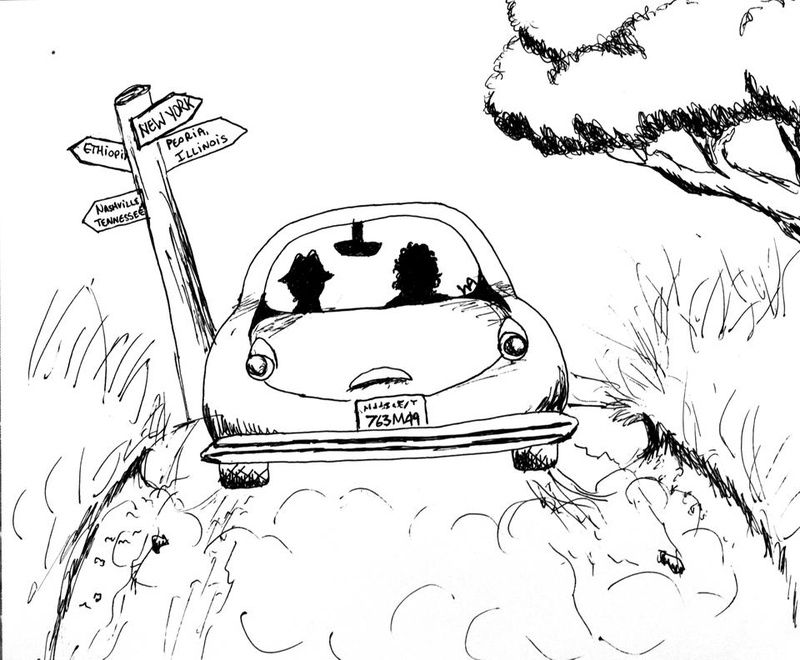The Nigerian-American writer Chimamanda Ngozi Adichie once warned about the danger of telling “a single story of Africa.” Narratives of Africa are usually collapsed into one tale of the tragedy of poverty, which a Western audience takes in with what Adichie describes as “patronizing, well-meaning pity.” The same can be said of the story of African immigrants. In Dinaw Mengestu’s “How to Read the Air,” Jonas Woldemariam works for a nonprofit, editing statements for refugees seeking asylum in the United States. In his job he spends more time rewriting than editing, and he admits that his embellishments could “easily be invented based on common assumptions most of us shared when it came to the poor in distant, foreign countries.”
Jonas’ use of “us,” which shows his lack of identification with the refugees, is conspicuous because he himself is the son of poor immigrants from the distant country of Ethiopia. “How to Read the Air” maps the crumbling relationship of two couples: Jonas’ parents and Jonas and his wife Angela. As his marriage unravels, Jonas recreates, through narrative and a literal road trip, a drive from Chicago to Nashville taken by his parents decades earlier. The difficulties of the immigrant experience is a constant presence in this examination of familial. Intimate in scope yet far-reaching in resonance, Dinaw Mengestu’s second novel “How to Read the Air” is a nuanced portrait of immigrants struggling with the vagaries of belonging in a country that is not quite home.
Mengestu’s own history—he was born in Ethiopia, grew up in Illinois, and finished his education in New York City—bears unsurprising similarities with that of his main character. The protagonists of his acclaimed first novel, “The Beautiful Things that Heaven Bears” are also Ethiopian immigrants. “How to Read the Air” is especially effective in juxtaposing the anxieties of first versus second generation immigrants. The eagerness of Jonas’s father to demonstrate his assimilation by visiting obscure landmarks in American history contrasts with Jonas’ haunting fear that he is too much like the parents against whom he, growing up American, has defined himself. “[Angela and I] were finding that we were still perhaps only a few degrees away from what came before,” he rues about his life.
Jonas hardly identifies as Ethiopian or even as an immigrant—if he identifies as anything at all. “Angela told me I lacked a clear sense of identity,” reports Jonas as discontent creeps into his marriage. Indeed Jonas is rather like a negative space at the center of the novel. Although the novel is narrated in his first person, never does he discuss his own emotions; it is always Angela telling him how he feels. He says he is “simply estranged from the great social machinations with which others were occupied.” That Mengestu manages to make the novel compelling despite having a man so lacking in solidity at its center speaks to his skill in writing between the lines.
“How to Read the Air” often seems to play out the well-worn tropes of a man in midlife crisis wandering, lost, around New York City. Jonas’ marital troubles and his status has a consummate outsider has shades of Hans van den Broek, the narrator of Joseph O’Neill’s “Netherland.” Whereas “Netherland” is grandly ambitious in its summoning of cricket fields, famous landmarks, and a mysterious death—much praise has been lavished on it as the definitive post-9/11 New York novel—“How to Read the Air” delves deeper into the subtleties and implications of a narrative that often folds in on itself. The prose is unfussy but the thematic design intricate.
At its core, the novel explores how prefabricated narratives can dominate over truth in the living out of our lives. This is illustrated through the universal example of the love story. Angela is forever measuring her life with Jonas against that ideal. They wander around New York looking for a café and park bench to claim as their own because that is what couples are expected to do. Their fraying marriage lingers as they act out “scenes plucked from a movie made to convince one that there was nothing more charming than being young and in love in New York.”
The same tension between truth and tidiness in narrative colors Jonas’ telling of his parents’ road trip. He interprets actions and recreates scenes—going so far as to toy with changing the actual events—justifying his changes with the idea that “history sometimes deserves a little revision.” Recalling his job writing refugee statements, he claims to be carrying out his “inevitable role as both advocate and judge over what happened between my parents during this trip.” His revision of history—influenced by a need to understand where his parents are coming from—is how he comes to terms with a childhood where one parent is absent and the other abusive.
This coming-to-terms underlies another story narrated by Jonas, that of his father’s escape from Ethiopia to America hidden in a cardboard box. The father’s harrowing journey is easily the novel at its most colorful and dramatic. However, it reads like one of Jonas’s doctored refugee statements, which, in fact, it is.
Jonas readily admits that he is fabricating the story. The deception should seem outrageous, but the story is also Jonas’ concession to his father in recognizing the forces that made him the petty and angry man that he becomes. “How to the Read Air” may be about African immigrants, but the individual stories of Jonas and his father entwine to produce a family history that is both complex and compelling.
Read more in Arts
‘Rock’ Proves Fun for All ‘Ages’Recommended Articles
-
 Olympian, Former Harvard Standout Ruggiero '02-04 Retires
Olympian, Former Harvard Standout Ruggiero '02-04 Retires -
 Who Needs the Jonas Brothers?
Who Needs the Jonas Brothers? -
Mock Trial Advances to Nationals in Mathew’s MemorySix weeks after the death of teammate Angela R. Mathew ’15 in a car accident, the Harvard Mock Trial team qualified for the national championship tournament.
-
From an Outsider Looking InAngela Matthews will always be a part of Harvard Mock Trial.
-
 Kids These Days
Kids These Days














